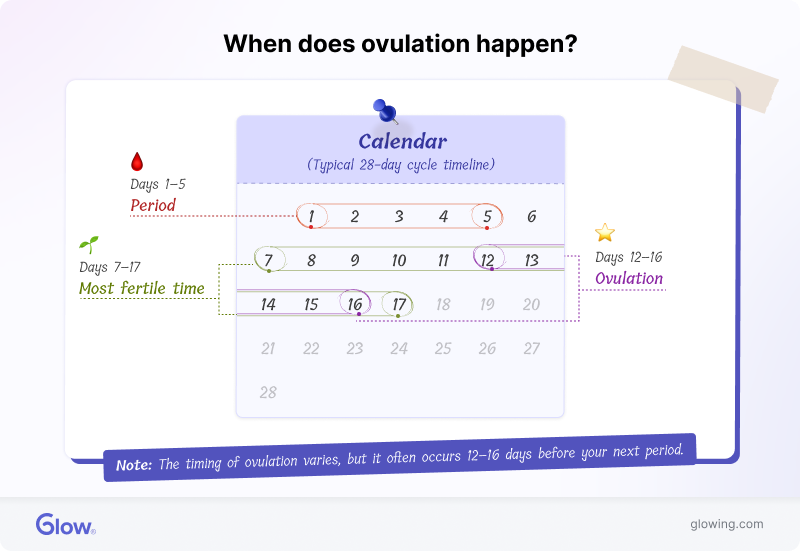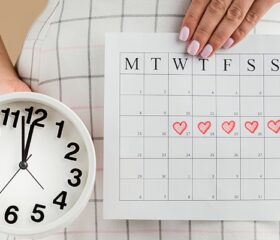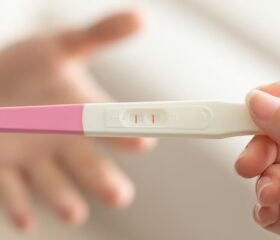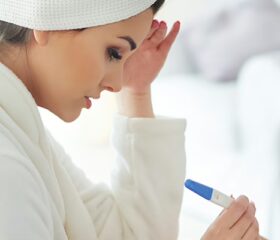Ovulation Symptoms: Signs, Timing, & Tracking
If you’re trying to start a family, the first step is understanding ovulation and when you’re most likely to conceive.

Whether you’re dreaming of being a mom or are avoiding it with all your might, knowing more about your menstrual cycle can benefit your health in a lot of ways.
How can you tell when you’re ovulating? Read on to find out what exactly ovulation is, what the most common signs of ovulation are, and how to track your cycle.
What happens during ovulation?
During the early stages of each menstrual cycle (which include your period and the days that follow it), your ovaries grow a few immature eggs in small sacs called follicles.
One of these ovarian follicles—or, more rarely, two or more—will mature faster than the others and become “dominant.”
A dominant follicle contains a mature egg that’s ready to be fertilized. 1
How your hormones trigger ovulation
Two hormones, follicle-stimulating hormone (FSH) and luteinizing hormone (LH), both play a role in ovulation.
FSH gives the initial signal for the follicles to start growing, while LH is responsible for ovulation itself. This hormone peaks right before you ovulate, telling the dominant follicle to release its egg. 2 3
Ovulation happens when this mature egg leaves your ovary and begins its journey down the fallopian tube. If it meets sperm and gets fertilized, it continues to the uterus and implants, meaning you’re now pregnant.
If there aren’t any sperm to meet or no sperm successfully fertilize the egg, the egg dies and comes out with the uterine lining during your period.
When does ovulation occur?
For most women, the menstrual cycle lasts 28 days, although in practice, it can range from 21 to 35 days.
Ovulation happens about halfway through your cycle, around 14 days after the start of your last period (and 14 days before your next one). 4
There’s a lot of wiggle room to this. Don’t be shocked if it happens anywhere from 12 to 16 days before your next period.
Because your cycle length can vary—from other people’s, and also from month to month—so can the timing of your ovulation.
How long does ovulation last?
Ovulation is short and sweet. It doesn’t take long for the egg to be released, and once it leaves the ovary, it’s only viable for 12 to 24 hours. 5 This means that about a day after ovulation, the window for potential pregnancy closes until the next month.
However, you’re actually fertile for about six days: the day of ovulation, plus the five or so days leading up to it. This makes sense when you consider that sperm can survive in your body for up to five days. 5
If you’re trying to conceive, you can give the egg its best chance at fertilization if sperm are already waiting for it in the fallopian tubes. In other words, have sex in the days leading up to ovulation.

What are the symptoms of ovulation?
You may find it hard at first to tell when you’re ovulating, but if you pay careful attention, you’ll start noticing patterns that point to it.
Keep an eye out for the following symptoms, but remember that you may still be ovulating even if you don’t experience any of them:
Cervical mucus
Your cervical mucus (vaginal discharge) changes throughout your cycle based on your fluctuating hormone levels, making it one of the most reliable ways to track your ovulation.
As you get close to ovulating, your estrogen rises, which increases the amount of cervical mucus your body makes. It also becomes slippery and stretchy to help sperm travel through the vagina and uterus. Many women call this mucus egg white discharge, as they claim it looks and feels like raw egg whites. 6
Sometimes, just checking your underwear is enough to spot this ovulation discharge. If you want a more thorough examination, stick a clean finger in your vagina and then see whether you can stretch the mucus between your fingers. If you can, you might be close to ovulating. 7
Basal body temperature
Your basal body temperature (BBT) is your resting temperature when you first wake up in the morning before you’ve even gotten out of bed.
Before ovulation, your BBT may dip slightly. Then, after ovulation, the hormone progesterone is released, which may cause your BBT to increase by about 0.5–1 degrees Fahrenheit and stay there until your next period (you need to use a basal thermometer with two decimal places so you can observe slight temperature fluctuations). 8 9
Since your temperature doesn’t rise until after ovulation, it’s really only confirmation that you’ve already ovulated. However, by tracking your BBT for several months, you’ll notice patterns in your cycle.
This makes it a decent way to predict your ovulation. It isn’t perfectly reliable—some women find that their BBTs don’t behave the way they “should”—but it can still help, especially if you use it alongside other tracking methods.
Pain and cramping
You might even feel ovulation when it happens. Some women report mild pain or cramping in the lower abdomen (on whichever side the ovary releasing the egg happens to be in) or even in their backs. This ovulation pain is sometimes called “mittelschmerz.” 10
These twinges can last a few minutes to a few hours and can feel like a dull ache or a sharp pang. Along with these pains, some women also report feeling bloated during ovulation. The pain and bloating shouldn’t be severe or prolonged, so talk to your doctor if it’s unbearable or doesn’t go away.
Don’t worry if you don’t feel your ovulation. Most women don’t feel it and have no idea when it’s happening. Just because you don’t have ovulation pain doesn’t necessarily mean you’re not ovulating: you’ll need to pay attention to your other symptoms to recognize when it’s happening.
Note that there’s no link between having ovulation pain and your chances of successfully getting pregnant (something that goes for all other ovulation symptoms, too—their strength has no correlation with how likely you are to conceive).
Other minor aches and physical symptoms
On top of these abdominal and back pains, your hormone fluctuations around ovulation can cause your breasts and nipples to feel sore and tender. 11
Libido
Your sex drive might amp up in the days leading up to ovulation. That’s because your hormones, including testosterone, rise around this time, which can send your libido into overdrive. Think of it as nature’s way of telling you to go make a baby. [12]
Spotting
Before the mature egg is released from the ovary, it’s just one of several eggs vying for the chance to be fertilized, each wrapped inside a follicle as it grows. Once an egg wins this race to maturity, the follicle containing it bursts open to send the egg into the fallopian tube.
Sometimes, this ruptured follicle bleeds a bit, causing light spotting or bloody discharge. 12 It won’t be as heavy as your period is (and will come substantially earlier)—be careful not to confuse the two.
The blood might be dark brown instead of red or pink if it takes a while to get all the way through the fallopian tube, into the uterus, and out of your vagina. The older the blood is, the more oxygen it’s been exposed to, making it darker. 13 This is the case for all types of brown discharge in pregnancy—not just implantation bleeding.
Cervical texture
Your cervix is the lowest part of your uterus, and you can feel it if you reach your fingers high into your vagina.
Your cervix’s position and texture change throughout your cycle. When you’re ovulating, it’s usually softer, wetter, and more open. It also sits higher in your vagina than at other times of the month. 14 You’ll know that ovulation is over once your cervix feels firmer and is positioned lower in your vagina.
You probably won’t be used to the texture of your cervix unless you check it regularly. With practice, though, you learn to spot these differences.
Heightened senses
Some women’s senses get stronger while they’re ovulating. You might find smells more powerful, and food might taste richer. 15
There isn’t a lot of research into this phenomenon, but it may be because of hormonal changes, like most of the other symptoms listed here. 16
Fluid retention and appetite changes
You may feel bloated around the time you ovulate as your estrogen peaks and your LH surges, which can cause your body to retain more water. 17 18
Your digestion might also slow down, making you feel less hungry and potentially giving you gas. Don’t worry; after a few days, the bloating will calm down and your appetite will pick back up.
Fatigue
Ovulation can make you feel tired, too. While the jury is still out on what causes fatigue around the time you ovulate, your hormonal changes could be to blame.
Before you ovulate, your levels of estrogen increase, which may give you a nice energy boost. However, your levels quickly drop after the egg is released. Couple this with your levels of progesterone (which have been linked to insomnia) rising after ovulation, and you’ve got a recipe for tiredness.
Mood elevation
Perhaps the most pleasant symptom of ovulation is a more positive mood. Many women feel their best during the middle of their cycle when hormones are high and their last period is a distant memory. Enjoy it while it lasts!
What if you don't ovulate?
Sometimes, ovulation doesn’t happen. This is called anovulation, and it has several potential causes:
- Pregnancy: If you’re pregnant, you won’t ovulate. Your body knows it already has a fertilized egg, so it doesn’t need to send any more down your fallopian tubes.
- Menopause: Once you reach menopause, you’ll stop ovulating and menstruating entirely.
- Hormonal birth control: While no birth control method is 100% foolproof, most hormonal birth control pills prevent pregnancy by keeping you from ovulating. If there’s no egg, there’s nothing for the sperm to fertilize.
- Medical conditions: Some health conditions, like polycystic ovary syndrome (PCOS) and premature ovarian failure, can interfere with ovulation. 19
- Lifestyle factors: If you’re significantly underweight or overweight, have chronic stress, or take certain medications, you might have trouble ovulating.
- Breastfeeding: When you’re breastfeeding your child exclusively, ovulation will most likely pause until you slow down or stop. In fact, many women use breastfeeding as a form of contraception; this is known as the lactational amenorrhea method (LAM). For the first 6 months of your baby’s life, it’s 98% effective. 20
If you have irregular periods, or if your cycle is much shorter than average (less than 21 days) or much longer (more than 35 days), that can also interfere with ovulation, and it can certainly make it much harder to predict. 21
If you’re in that camp, it’s a good idea to chat with your doctor to rule out potential medical conditions or other serious issues.
How to track your ovulation
You may be interested in tracking ovulation for two reasons: to get pregnant, or to avoid it.
If you’re trying to get pregnant, tracking your ovulation can boost your chances of getting pregnant more quickly. (Though ultimately, how long it’ll take you to get pregnant, even with tracking, can be difficult to predict.)
If you don’t want to get pregnant, monitoring your ovulation is also useful because it lets you know when not to have sex. Note that this isn’t a guaranteed way to avoid pregnancy, especially if you have irregular cycles (in fact, in rare circumstances, it’s even possible to get pregnant on your period).
As mentioned, you can track your BBT and keep an eye on your cervical mucus to get a better idea of when you’re ovulating. You could even create an ovulation calendar (or use an ovulation calculator to do it for you).
If you’re tracking ovulation with irregular periods, you may need more tailored guidance from your doctor or a fertility specialist.
Ovulation predictor kits
Outside of tracking your ovulation with the previously mentioned methods, you could also use an ovulation test strip, also known as an ovulation predictor kit (OPK). These tell you how much LH you have in your urine or saliva. OPKs come with ovulation test strips or sticks that you pee on, much like a pregnancy test. Some are designed to test your spit instead.
Depending on what kind of kit you get, you may be able to just look for a positive or negative result to see if you’re likely to ovulate soon. You may also have to compare the color of your test line against the color of a control line. If the lines match, your ovulation test is positive, and you can expect to ovulate shortly.
You’ll have a good chance of getting pregnant after seeing a positive ovulation test result, so you’ll want to have sex once you get one.
Generally, ovulation tests are accurate, but to use them effectively, you have to know when to start testing. If you have a regular cycle, this should be easy. If your cycle is irregular, pay attention to your other symptoms and test when they peak.
For the most accurate results, do the test around the same time each day.
Can an ovulation predictor kit tell you if you’re pregnant?
While these tests are designed to detect ovulation, sometimes, ovulation tests will be positive if you’re pregnant. That’s because LH is similar to human chorionic gonadotropin (hCG), which is what pregnancy tests look for. If you’re pregnant, the test may mistake hCG for LH and give you a positive result.
However, ovulation tests aren’t a reliable way of confirming pregnancy. It’s best to use both ovulation and pregnancy tests for their intended purpose.
Fertility monitors
Fertility monitors are similar to ovulation predictor kits, but they’re much more comprehensive and, as a result, are more expensive.
They track more than just LH; they keep an eye on other fertility indicators, like your estrogen levels and BBT, too. All this information not only helps you pinpoint ovulation but also tells you which days you’re most fertile in each cycle.
Some fertility monitors use an app, and others are handheld digital devices. Some even store information about your past few cycles to help predict your fertility more accurately. If you’re trying to get pregnant, a fertility monitor can help you decide the best times to have sex to conceive.
Final thoughts
While trying to figure out when you’re ovulating can be a confusing (and often tiring!) process, getting to grips with your cycle gives you a better chance of getting pregnant—or avoiding it entirely, depending on what your goal is.
If you’ve been trying to conceive for more than 6 months to 1 year and it just isn’t happening, see your doctor to rule out potential fertility issues. Otherwise, good luck, and happy tracking.
Article Sources
- Penn Medicine Lancaster General Health. "Understanding Ovulation and Your Reproductive Cycle" Retrieved April 17, 2025.
- University of Rochester Medical Center. "Follicle-Stimulating Hormone" Retrieved April 17, 2025.
- University of Rochester Medical Center. "Luteinizing Hormone (Blood)" Retrieved April 17, 2025.
- Office on Women's Health. "Trying to conceive" Retrieved April 17, 2025.
- Office on Women's Health. "Your menstrual cycle" Retrieved April 17, 2025.
- American Pregnancy Association. "Cervical Mucus and Early Pregnancy" Retrieved April 17, 2025.
- Planned Parenthood Federation of America Inc.. "What's the cervical mucus method of FAMs?" Retrieved April 17, 2025.
- MedlinePlus. "Definitions of Health Terms: General Health" Retrieved April 17, 2025.
- MedlinePlus. "Pregnancy - identifying fertile days" Retrieved April 17, 2025.
- Mount Sinai. "Mittelschmerz" Retrieved April 17, 2025.
- Johns Hopkins Medicine. "Breast Pain (Mastalgia)" Retrieved April 17, 2025.
- Cleveland Clinic. "Ovulation" Retrieved April 17, 2025.
- Northwestern Medicine. "What Your Period Says About Your Health" Retrieved April 17, 2025.
- Tommy’s. "Ovulation and fertility" Retrieved April 17, 2025.
- Whole Systems Healthcare. "Signs Ovulation Is Happening: A Comprehensive Guide" Retrieved April 17, 2025.
- Rhinology International Journal. "Menstrual cycle-modulated intrinsic connectivity enhances olfactory performance during periovulatory period" Retrieved April 17, 2025.
- Cleveland Clinic. "Ovulation" Retrieved April 17, 2025.
- Intersono Medicover Group. "Severe Bloating During Ovulation: Causes, Symptoms, and Treatment" Retrieved April 17, 2025.
- Johns Hopkins Medicine. "Polycystic Ovary Syndrome (PCOS)" Retrieved April 17, 2025.
- Planned Parenthood Federation of America Inc.. "Breastfeeding" Retrieved April 17, 2025.
- Eunice Kennedy Shriver National Institute of Child Health and Human Development. "What are menstrual irregularities?" Retrieved April 17, 2025.





